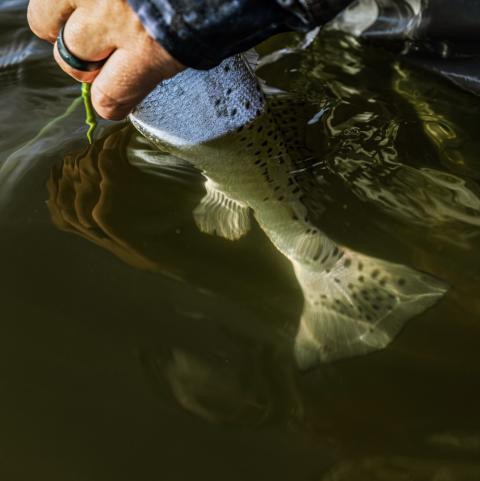
Will Garrett Mundhenke
Flipping through the pages of Dr. Matthew R. Lewis’ Fly Fishing for Redeye Bass: An Adventure Across Southern Waters feels like taking a fly fishing trip with both a good friend, and simultaneously, your professor. The first of many read throughs for me came in 2020 when I first learned that a blue-cheeked bass existed in the South. The Bartram’s Bass was the Redeye that drew me into self-identifying as a “Redeye Angler” – for better or worse – and has since consumed my every waking moment outside of turkey season. Lewis draws upon his own experience and passion for Redeye Bass fishing to bring the reader into a new world of black bass diversity, threats to native species, and important conservation messages we should all hear.
Most anglers picking up this book will be new to the most basic of concepts – what is a Redeye Bass? Lewis begins with a generalized description and moves into more scientific and genetic understandings of the features that differentiate our seven species of Redeye. Fly Fishing for Redeye Bass is a great choice for recreational anglers and conservationists that enjoy leaving the great outdoors a little better than when they arrived.
Lewis starts with the definitive subjects of biology and conservation but quickly moves towards a how-to style of angling for Redeye Bass. He discusses their forage items such as terrestrial insects and nymphs and how these prey species fit into their overall ecological makeup. He does the reader a genuine favor by likening these insects and baitfish to commonly used flies and lures that is helpful for anglers of all experience levels. Fly Fishing for Redeye Bass covers important topics such as seasonal differences when fishing for Redeye, angling tactics, and useful gear for a day on the water.
Perhaps the most important chapter in the book is called “Native Ranges.” These pages work through each native drainage – seven distinct watersheds for seven distinct Redeye Bass – while including the history, usage, threats, and conservation needs of each drainage. This chapter is where Lewis’ passion for each individual fish truly shines and the angler benefits from his tireless detail covering each of the seven species that may be in your backyard. Knowing the native range of each of the species will help anyone chasing after the Redeye Slam and attempting to catch all seven in a calendar year – a program also created by Matt Lewis to raise awareness for the Redeye Bass.
Fly Fishing for Redeye Bass is the first of its kind. The only book purely dedicated to Redeye Bass and their angling. I am certainly grateful for the wisdom in its pages and I am sure every new reader will feel the same. Not only will you walk away knowing how to fish for Redeye Bass, but you will leave the book being a better conservationist and a more thoughtful outdoorsman. As Lewis accurately states, “these fish offer something much deeper, something that is becoming more and more rare these days. Fly fishing for redeye bass offers adventure into remote and quiet streams well off the beaten path.” Once you finish this book, I am sure you will find yourself knee-deep in a mountain stream chasing Redeye Bass. You will certainly have a richer life for doing so.
You can purchase Dr. Matthew Lewis’ Fly Fishing for Redeye Bass: An Adventure Across Southern Waters onAmazon. Be sure to check out the official website for Redeye Bass fishing at www.redeyebassflyfishing.com.




























